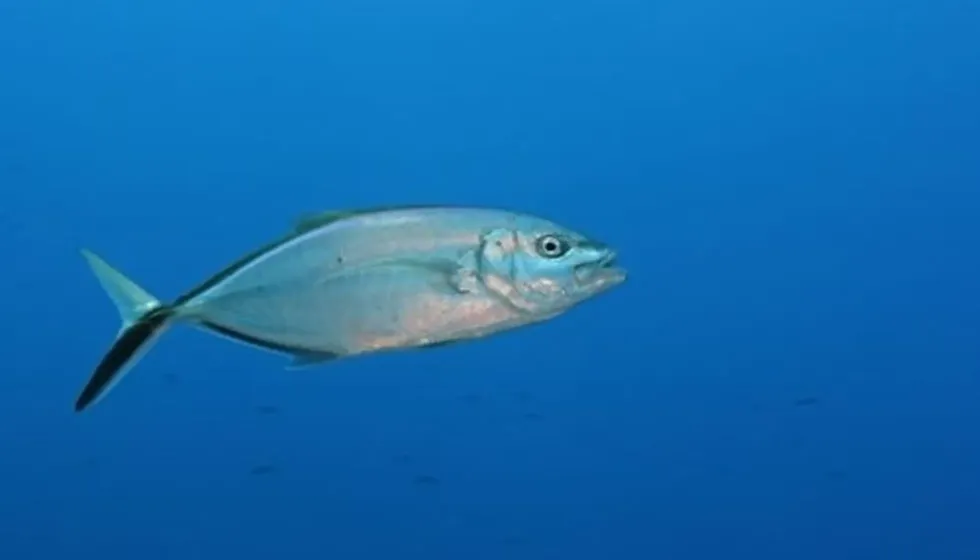The bar jack is a common species of ray-finned trevally, or jackfish, in the family Carangidae. It is variably classified, sometimes as Carangoides ruber, and sometimes as Caranx ruber. The Caranx genus classification is more popular among naturalists.
The bar jack is also known by other names, including carbonero, red jack, blue striped cavalla, and passing jack. They can all be distinguished from other trevally by the dark horizontal bar that runs along the center of their back, right up to the caudal fin.
Directly below this is an electric blue stripe, which further highlights the dark bar. They also have a silvery body and elongated shape that is typical to most jackfish.
This mid to large-sized marine animal is found near coral reefs, in clear shallow waters along the Atlantic Ocean. It is a popular game fish and needs a light tackle along with an assortment of lures and baits. A bar jack is also known to have ciguatera toxicity, hence, has the potential to cause food poisoning.
Today, the majority of its population is centered in the West Indies and the Gulf of Mexico. It is also found in Bermuda, and some North American and South American shorelines (New Jersey, Venezuela, Brazil).
At Kidadl, you can explore several other fascinating marine species, including spotfin chub facts and Jack Dempsey facts.
Bar Jack Interesting Facts
What type of animal is a bar jack?
A bar jack is a mid-sized marine animal.
What class of animal does a bar jack belong to?
A bar jack belongs to the Actinopterygii class of fish.
How many bar jacks are there in the world?
The exact count of bar jacks is unknown, but this is not an Endangered species. In fact, marine experts estimate that there are millions of bar jacks thriving in the Atlantic Ocean water in their natural habitat.
Where does a bar jack live?
A bar jack lives in a large water body, like an ocean or a sea.
What is a bar jack's habitat?
A bar jack prefers clear shallow waters, near coral reefs (less than 60 ft (18 m) deep). It is found along the tropical and sub-tropical shorelines of the Atlantic Ocean.
The largest population in this species is centered in the Gulf of Mexico, West Indies, and the Caribbean waters. It can also be found in smaller numbers at both ends of the Atlantic Ocean shoreline. This includes Bermuda and the North American shoreline in New Jersey, and the South American shoreline in Venezuela and Brazil.
A bar jack is an active, diurnal, non-sedentary fish. So it tends to travel a distance. It also hits deeper waters for its food (small fish, crustaceans, mollusks). Its normally silvery body takes on a darker color as it goes deeper into the water.
A bar jack is also known to venture into lagoons, especially while crossing between larger water bodies. During this time, it may be protected by association with barracudas, stingrays, and sharks. In fact, juvenile bar jacks often stay close to stingrays and feed on their debris.
Who do bar jacks live with?
A bar jack lives with hundreds of fish in a group called a school or a shoal. Bar jacks even hunt for food in shoals. They are hence called schooling fish. In some cases, a shoal may swim close to a larger fish (like a stingray), both for protection, and to feed on its debris.
This is also a very active fish species that covers a fair bit of distance every day. So it is not uncommon to spot a solitary fish all by itself looking for food in deeper waters.
How long does a bar jack live?
A bar jack can live for 8-10 years.
How do they reproduce?
The sexual maturity of bar jacks is measured not by age, but by size. For instance, the males are ready to breed when they reach 10 in (25 cm) long. Females wait until they are at least 12 in (31 cm) long, so they can hold the eggs.
Breeding happens twice a year, just after the dry and wet season (when the female is big enough to carry eggs). In fact, both sexes have the tendency to eat more, typically during the dry and wet season, to prepare for breeding.
These schooling fish are a social species. They hunt in large shoals, and also breed in large shoals. A male-female pair will move away from the shoal to breed.
During this time, the female discharges a large number of unfertilized eggs into the surrounding water. This process is called spawning. The male releases his sperm instantly to fertilize the eggs.
A female bar jack can release a large number of eggs during spawning that can be in the range of 67,000 – 231,000. Each egg goes through the typical fish development lifecycle, hatching into larvae when they are 0.07 in (2 mm) in length.
When the larvae turn into young fry (also called juveniles), they often live near seaweed algae for protection and feed of its debris.
What is their conservation status?
The conservation status of bar jacks is of Least Concern according to the IUCN.
Bar Jack Fun Facts
What do bar jacks look like?

Bar jacks belong to the ray-finned trevally species and have an elongated body with a silvery-gray or silvery-blue hue. Its dorsal fin has two parts; the longer part has eight spines, and the shorter part has one spine. The entire body of the fish becomes darker in color when it enters deeper waters to feed.
The bar jack is identified by two striking visual characteristics. The first is the dark horizontal bar along the back of this fish, right up to the caudal fin. Directly below this bar is a second bar, in electric blue.
It also has 10-14 upper gill rakers and 31-38 lower gill rakers. The count of gill rakers may be used to distinguish juveniles from other common species like the yellow jack.
The horizontal bars develop with the growth of the fish. The largest fish in this jack species can grow up to 25 in (63.5 cm) long and weigh between 15-18 lb (7-8 kg).
How cute are they?
The bar jacks are cute when viewed from a distance, like in a large aquarium, as their silvery body shimmers. They are also fast swimmers.
Fishers may find them especially cute as game fish since they are easy to catch with a light tackle and an assortment of lures.
How do they communicate?
Fish communicate through non-verbal cues. Bar jacks use their eyes to sight their prey. They also use signals and electric pulses to communicate. For instance, male and female bar jacks use a body tremble signal before they mate.
How big is a bar jack?
A bar jack (Carangoides ruber) is 15-25.6 in (38-65 cm) long and is almost twice the size of a large goldfish.
How fast can a bar jack swim?
A bar jack is a very fast swimmer. In theory, a large, 25 in (63.5 cm) bar jack can cover 0.55 mi (0.25 km) in just a second.
How much does a bar jack weigh?
The weight range of a bar jack (Caranx ruber) is between 15-18 lb (7-8 kg). They are considered medium to large fish.
What are the male and female names of the species?
Both the male and the female in this species are called by the same name.
What would you call a baby bar jack?
A baby bar jack is called a fry. Also, a fish egg in this species first hatches into a larva before it transforms into a young fry.
What do they eat?
Bar jacks (Carangoides ruber) are carnivores predators and feed on smaller fish, crustaceans, and mollusks. For this, they may hunt in shallow waters, or swim down to deeper waters. In fact, there are recorded instances of the bar jack feeding in water levels at a depth of 328 ft (100 m) below the surface!
This is also a species that does not feel the need to eat every day. Juvenile bar jacks may eat throughout the ear, to support their growth, but adult bar jacks have the tendency to pile on the food during the dry and rainy seasons, just before spawning.
They can also go for days without food during the winter and summer months.
Are they dangerous?
They are mid-sized fish, no more than 25 in (63.5 cm) long. So they are not as dangerous to humans as large sharks. They are also eaten by some communities.
Many people avoid eating this fish, as it can be ciguatera toxic, with the ability to cause fish poisoning when eaten. Also, this ciguatera toxic quality is common across most jackfish, including the black jack and yellow jack. Hence, one must avoid eating them unless they are sure of the quality of the fish.
Would they make a good pet?
No, these carnivorous animals are not known to be good pets.
Did you know...
Caranx, the genus of this fish species, is derived from the word 'Carangue', which points to jackfish, or trevally in French.
The bar jack species was first classified under the genus Somber in 1793, based on a specimen spotted on the east coast of America. The Somber species is often used for mackerels and other common fish found in the sea.
The bar jack was reclassified under the existing Caranx genus in 1801, as the genus and species were identified and named by the French naturalist, Bernard Germain de Lacépède.
Can you eat bar jack fish?
Yes, you can eat the bar jack (Carangoides ruber) fish. In fact, it is a popular sport or game fish.
A few words of warning here. This species is also known to be ciguatera toxic, with the ability to cause fish poisoning (like food poisoning). It can be a carrier of diseases that are transmitted through consumption. Also, the highest number of bar jack fish-poisoning cases was recorded on the island of Saint Thomas, in the U.S. Virgin Islands.
It is hence best to check the history and quality of the bar jack in your locale before you decide to consume it.
Naming the bar jack
The bar jack (Carangoides ruber) gets its name from its visual appearance, based on the dark horizontal bar that runs along its entire back right up to its caudal fin. This is also used as a distinguishing feature to identify this species from other jackfish.
In some subspecies, the dark bar is further highlighted by an electric blue bar right below it. So it is also known as, blue-striped cavalla. Here, 'cavalla' is the term used for fish in the family Carangidae in many local dialects.
The bar jack (Caranx ruber) is also called a red jack, due to its species (ruber). The word 'ruber' literally translates to 'red' in Latin.
As you can see, this fish is quite the polyonymous marine animal with so many known names! It is known by a host of other names, including carbonero, red jack, blue-striped cavalla, passing jack, neverbite, pointnose, jack bar, and more. However, it remains most well-known as bar jack.
Here at Kidadl, we have carefully created lots of interesting family-friendly animal facts for everyone to discover! Learn more about some other fish from our Atlantic herring facts and bluefin tuna facts.
You can even occupy yourself at home by coloring in one of our free printable bar jack coloring pages.










